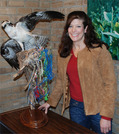
Learn about animal rehabilitators and create your own vehicle to transport a wounded animal.
- Subject:
- Ecology
- Engineering
- Zoology
- Material Type:
- Activity/Lab
- Author:
- Rachel Dellman
- Date Added:
- 01/31/2020

Learn about animal rehabilitators and create your own vehicle to transport a wounded animal.

In this unit of study students learn how an animal's body structure and behavior help it survive in its habitat. This unit integrates nine STEM attributes and was developed as part of the South Metro-Salem STEM Partnership's Teacher Leadership Team. Any instructional materials are included within this unit of study.
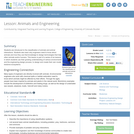
Students are introduced to the classification of animals and animal interactions. Students also learn why engineers need to know about animals and how they use that knowledge to design technologies that help other animals and/or humans. This lesson is part of a series of six lessons in which students use their growing understanding of various environments and the engineering design process, to design and create their own model biodome ecosystems.

Antimatter, the charge reversed equivalent of matter, has captured the imaginations of science fiction fans for years as a perfectly efficient form of energy. While normal matter consists of atoms with negatively charged electrons orbiting positively charged nuclei, antimatter consists of positively charged positrons orbiting negatively charged anti-nuclei. When antimatter and matter meet, both substances are annihilated, creating massive amounts of energy. Instances in which antimatter is portrayed in science fiction stories (such as Star Trek) are examined, including their purposes (fuel source, weapons, alternate universes) and properties. Students compare and contrast matter and antimatter, learn how antimatter can be used as a form of energy, and consider potential engineering applications for antimatter.

make a paper cut out of the Apollo moon landing capsule.
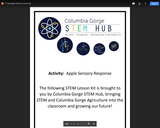
In this lesson, students will explore apples using their five senses. Includes activity instructions, extension activities, songs, and apple and five senses realted reading list.
NGSS: K-ESS3-1, 1-LS1-1
Time: 30 minutes
Materials: "Apples Grow on Trees" or other book about apples.
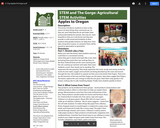
In this lesson, students are introduced to trees and the many things we commonly use that come from trees. Includes introductory movement activity, guided discussion, a matching game, and fun facts.
NGSS: Partially meets 1-LS1-1, 2-PS1-1, 2-PS1-2
Common Core: W.2.7, W.2.8
Time: 30 minutes
Materials: "Apples to Oregon" book and three paper lunch bags labled: wood, food, cellulose.
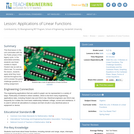
This final lesson in the unit culminates with the Go Public phase of the legacy cycle. In the associated activities, students use linear models to depict Hooke's law as well as Ohm's law. To conclude the lesson, students apply they have learned throughout the unit to answer the grand challenge question in a writing assignment.

Students explore Hooke's law while working in small groups at their lab benches. They collect displacement data for springs with unknown spring constants, k, by adding various masses of known weight. After exploring Hooke's law and answering a series of application questions, students apply their new understanding to explore a tissue of known surface area. Students then use the necessary relationships to depict a cancerous tumor amidst normal tissue by creating a graph in Microsoft Excel.
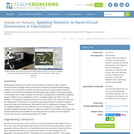
Measuring the dimensions of nano-circuits requires an expensive, high-resolution microscope with integrated video camera and a computer with sophisticated imaging software, but in this activity, students measure nano-circuits using a typical classroom computer and (the free-to-download) GeoGebra geometry software. Inserting (provided) circuit pictures from a high-resolution microscope as backgrounds in GeoGebra's graphing window, students use the application's tools to measure lengths and widths of circuit elements. To simplify the conversion from the on-screen units to the real circuits' units and the manipulation of the pictures, a GeoGebra measuring interface is provided. Students export their data from GeoGebra to Microsoft® Excel® for graphing and analysis. They test the statistical significance of the difference in circuit dimensions, as well as obtain a correlation between average changes in original vs. printed circuits' widths. This activity and its associated lesson are suitable for use during the last six weeks of the AP Statistics course; see the topics and timing note below for details.
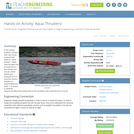
In this activity, students construct their own rocket-powered boat called an "aqua-thruster." These aqua-thrusters will be made from a film canister and will use carbon dioxide gas produced from a chemical reaction between an antacid tablet and water to propel it. Students observe the effect that surface area of this simulated solid rocket fuel has on thrust.
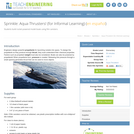
Students build rocket-powered model boats using film canisters.
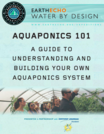
In this curricular guide, middle school students learn about an alternative farming technique that addresses water use in agricultural farming, the environmental impacts of fish farms, and urban development and population growth. This guide promotes 21st-century skills by engaging students in the history of aquaponics through various texts; improving their communication skills by explaining how an aquaponics system works; and engineering your own classroom aquaponics unit through an interactive design challenge!
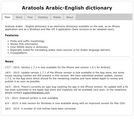
Aratools is an online dictionary that includes over 80,000 stems to translate from Arabic to English and from English into Arabic. The output provides a root-based translation for words and will provide the word's root and conjugation if it is a verb, as well as prefix and suffix morphology. A highly rated iOS app can be purchased to access the dictionary in mobile format.

Students are introduced to Pascal's law, Archimedes' principle and Bernoulli's principle. Fundamental definitions, equations, practice problems and engineering applications are supplied. A PowerPoint® presentation, practice problems and grading rubric are provided.
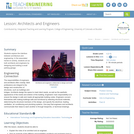
Students explore the interface between architecture and engineering. In the associated hands-on activity, students act as both architects and engineers by designing and building a small parking garage.

This is the second undergraduate architecture design studio, which introduces design logic and skills that enable design thinking, representation, and development. Through the lens of nano-scale machines, technologies, and phenomena, students are asked to explore techniques for describing form, space, and architecture. Exercises encourage various connotations of the "machine" and challenge students to translate conceptual strategies into more integrated design propositions through both digital and analog means.
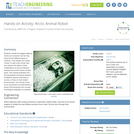
Students create four-legged walking robots and measure how far they travel across different types of surfaces. They design and create "shoes" to add to the robots' feet and observe the effect of their modifications on the net distance traveled across the various surface types. This activity illustrates how the specialized locomotive features of different species help them to survive or thrive in their habitat environments. The activity is best as an enrichment tool that follows a lesson that introduces the concept of biological adaptation to students.
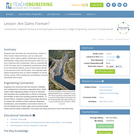
Students learn that dams do not last forever. Similar to other human-made structures, such as roads and bridges, dams require regular maintenance and have a finite lifespan. Many dams built during the 1930-70s, an era of intensive dam construction, have an expected life of 50-100 years. Due to inadequate maintenance and/or for environmental reasons, some of these dams will fail or be removed in the next 50 years. The engineers with Splash Engineering have an ethical obligation to remind Thirsty County of the maintenance and lifespan concerns associated with its dam.
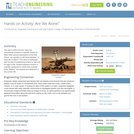
The year is 2032 and your class has successfully achieved a manned mission to Mars! After several explorations of the Red Planet, one question is still being debated: "Is there life on Mars?" The class is challenged with the task of establishing criteria to help look for signs of life. Student explorers conduct a scientific experiment in which they evaluate three "Martian" soil samples and determine if any contain life.